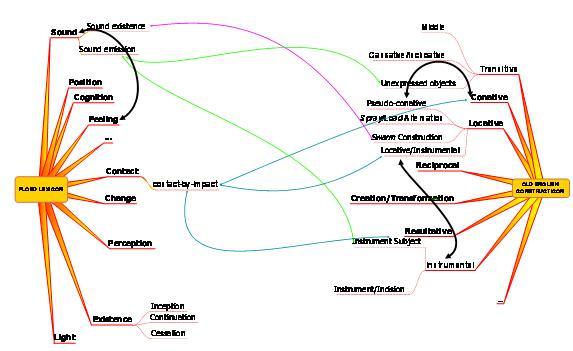

GiLGLi
Spanish-English Core Grammar Database within the LCM
Our
current research is devoted to the elaboration of a Spanish-English
database
for lexical and constructional structures. This research is part of the
project Construcción de una base de datos
léxica
y construccional inglés-español en el nivel de
gramática nuclear, funded by
the Spanish Ministry of Education, Reference no. FFI2008-05035-C02-02.
The research team for
this project is formed by the GilGli members and Drs. Isabel
González Aguiar
(University of La Laguna), Francisca Plaza Picón (University of
La Laguna) and
Carolina Rodríguez Juárez (University of Las Palmas de
Gran canaria).
The grammatical framework for this project is the Lexical
Constructional Model (LCM), a model of meaning construction in terms of
four
levels of semantic representation: a nuclear level, which includes the
socalled
argument structure constructions, a pragmatic level, an illocutionary
level and
a discourse level. Our task is to develop the internal structure of the
first
layer, the so called Core Grammar Level.
The Core Grammar of a language
is composed of a thesaurus, or repository of lexical units with their
corresponding lexical templates and a catalogue of constructions of a
language
—the constructicon—also endowed with a semantic
description. The interaction
between these two modules is determined by a set of subsumption
operations and
constraints. Within the context of this model, Level
1 semantic interpretation is the result
of the subsumption of (a) lexical template(s) (i.e. a low-level
representation
of the semantic and syntactic properties of a predicate) in a
constructional
template (i.e. a high-level representation of the semantic properties
of a
construction).
The Lexical
Constructional Model- Core Grammar
It is the aim of our project to study core grammar or
level 1
constructions in order to create an inventory and make this database
contrastive between English and Spanish. The two languages show
similarities
but also significant differences in terms of constructional variation,
something that will have to be taken into account for language teaching
and
translation (including automated translation) purposes.
Our task is, therefore, twofold for each language: we
need to
organize a Thesaurus –or repository of lexical units- and a
Constructicon –or
catalogue of constructions- and also it is neccessary to estbalish the
set of
interface rules and restrictions that bind elements from both modules.
A
graphic represetation of this process could be the following:

The Lexical Constructional Model postulates the existence
of
higher-level constructions with an independent status. The
establishment of
such higher level constructions is the task of the other research
groups that
form part of Lexicom.